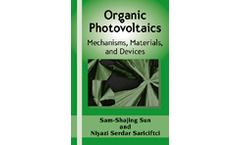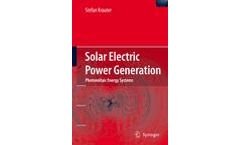pv-racking-system books
8 books found
Recently developed organic photovoltaics (OPVs) show distinct advantages over their inorganic counterparts due to their lighter weight, flexible shape, versatile materials synthesis and device fabrication schemes, and low cost in large-scale industrial production. Although many books currently exist on general concepts of PV and inorganic PV materials and devices, few are available that offer a ...
Thermophotovoltaic (TPV) technology is a promising new means for the direct conversion of thermal to electric energy. Its potential applications range from military power, to space propulsion, to commercial products for market niches in auxiliary power sources, co-generation of electricity and heat, and high temperature waste heat utilization. The papers in this conference volume are divided into ...
Solar photovoltaics is one of the most promising renewable energy technologies, producing electricity on site directly from the solar radiation without harming the environment and depletion of materials. The Building Integrated Photovoltaic Thermal (BIPVT) system is a technology which merges PV and thermal systems, simultaneously providing both electric and thermal energy. Through this ...
Drawing on the authors’ extensive research and project implementation around the globe, Solar Energy: Renewable Energy and the Environment covers solar energy resources, thermal and photovoltaic systems, and the economics involved in using solar energy. It provides background theory on solar energy as well as useful technical information for implementing solar energy applications. The book ...
All papers were peer reviewed. Thermophotovoltaic (TPV) devices convert heat into electricity using photovoltaic (PV) cells. Typically, the system consists of an emitter, a spectral control component and a PV cell. Some applications are: solar systems, space power applications, solar greenhouse or home heating furnaces. Thermophotovoltaic (TPV) technology is a promising new means for the direct ...
All papers were peer reviewed. Thermophotovoltaic (TPV) devices convert heat into electricity using photovoltaic (PV) cells. Typically, the system consists of an emitter, a spectral control component and a PV cell. Some applications are: solar systems, space power applications, solar greenhouse or home heating furnaces. Thermophotovoltaic (TPV) technology is a promising new means for the direct ...
The search for clean, renewable energy sources has yielded enormous growth and new developments in these technologies in a few short years, driving down costs and encouraging utilities in many nations, both developed and developing, to add and expand wind and solar power capacity. The first, best-selling edition of Wind and Solar Power Systems provided the most complete and modern treatment of ...
Solar electricity is a viable, environmentally sustainable alternative to the world’s energy supplies. In support, Dr. Krauter thoroughly examines the various technical parameters of photovoltaic systems. Study of performance and yield (including optical, thermal, and electrical parameters and interfaces) are analyzed. The net energy balance of photovoltaic systems – from production, operation ...






